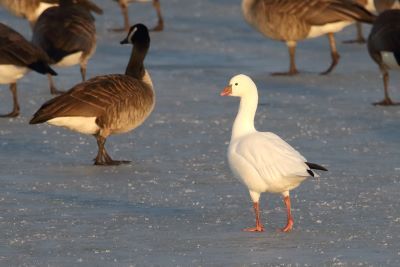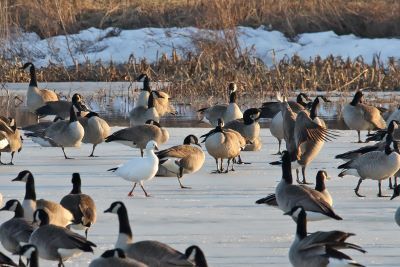
Good Natured: The Ross's Goose
It's that time of year again folks—spring waterfowl migration! With millions of birds on the move, any outdoor excursion can ramp up from ordinary to extraordinary, provided you're paying attention.
Such was the case a few weeks ago for my friend Gordon Garcia, a birder who's also a gifted wildlife photographer.
Gordon had been out taking in the sights and sounds of the retention pond at James O. Breen Community Park in St. Charles. (I know, it sounds weird, watching birds in a manmade basin. But it really is a popular spot with birds, and the birding crowd. I suspect if we were to go back in time, we'd see that the area was once a giant wetland complex. Miles of drain tiles today keep the soccer fields there dry, but back in the day I'll bet it was bountiful marshland.)
Let's see, where were we? Ah, yes, Gordon's most excellent photos. He, and a gaggle of other birders scanning the Canada geese in and around the pond, noted that one of the birds was not like the others.
Its white plumage caught their eye, but there was more to it than that. This bird was notably smaller than the others too, with a short neck and a stubby bill--a Ross's goose, Anser rossii.
I'll admit, the first thing I thought when I saw Gordon's pictures was, “Aw, what a cutie!"
Turns out I'm not alone. eBird, the revered bird observation database, describes the Ross's goose as a “Cute miniature version of Snow Goose with smaller body, shorter neck, and stubbier bill."

I should add, cute, and quite white. Unlike their larger cousins the snow geese, which tend to dig around a lot as they feed, pulling up tubers and such in marshy water, Ross's geese prefer to feed on short grasses and emergent aquatic plants. Their plumage stays white, while snow geese often acquire a yellow cast.
Although not an endangered species, Ross's geese are unusual in this part of Illinois. They're something to take note of—and report to eBird, which many birders did.
Wintering and migrating Ross's geese usually are found in flocks farther south and west from Kane County, in the wetland complexes along the Illinois and Mississippi Rivers. As the breeding season approaches, the birds head back to their nesting grounds waaay up north in the Canadian tundra.
There's no way to know what brought this individual in for a few hours of R&R—rest and refueling; Gordon mentioned that it likely departed later that same day. With any luck, it's been reunited with other Ross's that are now making their way northward.
Its visit, though brief, got me curious as to the species' history. It turns out, Ross's geese were rare indeed just 100 years ago, with population estimates of between 3,000 and 6,000 birds total. But thanks to changes in agricultural practices that have resulted in a lot of grains to forage on during migrations, Ross's geese have made a remarkable recovery. Today's estimates place the population at more than 2 million-- an increase, if I did the math right, of 40,000%
Given that this is a species we might well be seeing more of in the coming years, I thought it might be prudent to know how it acquired the name Ross's. The designation, I learned, dates to 1861—a time well before the first Ross I could think of, Diana, and 25 years after the passing of the second one that came to mind, Betsy.
It turns out these geese owe their appellation to one Bernard Rogan Ross, a trader and astute naturalist with the Hudson's Bay Company. Among the many specimens he sent to the Smithsonian Institution in Washington DC were some small white geese he insisted were a species separate from the snow geese. As a result of his persistence, his identity became forever intertwined with that of A. rossii.
Prior to that time, folks referencing this cute little goose used a variety of common names including galoot, crazy galoot and silly galoot; scabby-nosed wavey, which referred to the bumps at the base of the bill; and the name favored by Arctic explorer Samuel Hearne: horned wavey.
Hearne's observations, published posthumously in 1795, read like a combination of field guide and Bon Appetit: “This delicate and diminutive species of the Goose is not much larger than the Mallard Duck. Its plumage is delicately white, except the quill-feathers, which are black. The bill is not more than an inch long, and at the base is studded round with little knobs about the size of peas, but more remarkably so in the males…about two or three hundred miles to the North West of Churchill, I have seen them in as large flocks as the Common Wavey, or Snow Goose. The flesh of this bird is exceedingly delicate; but they are so small, that when I was on my journey to the North I eat two of them one night for supper."
Spring waterfowl migration isn't over yet. You've got time yet to head out and look for the ordinary—which are still pretty cool—and the extraordinary…every last horned, scabby-nosed, crazy, silly one of 'em.
Pam Otto is the outreach ambassador for the St. Charles Park District. She can be reached at potto@stcparks.org.

